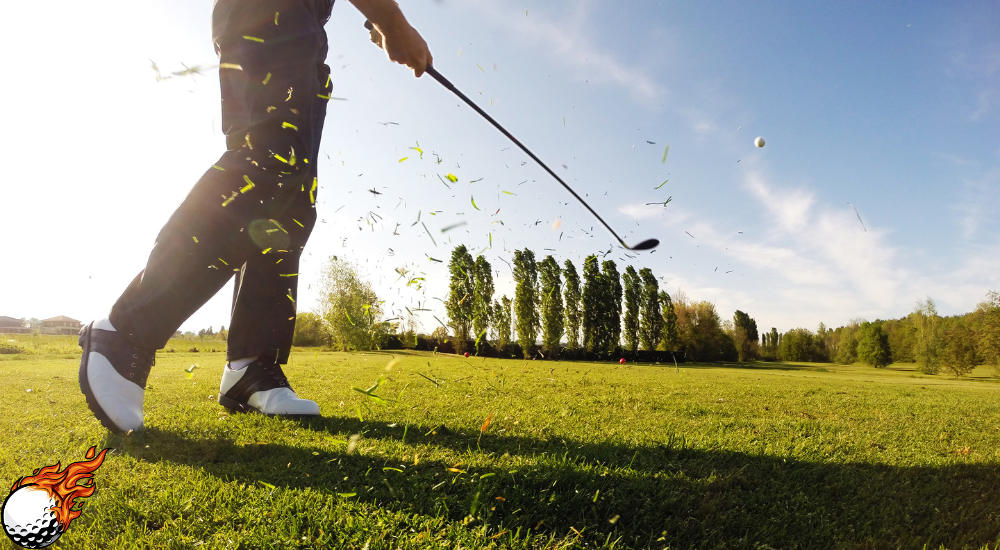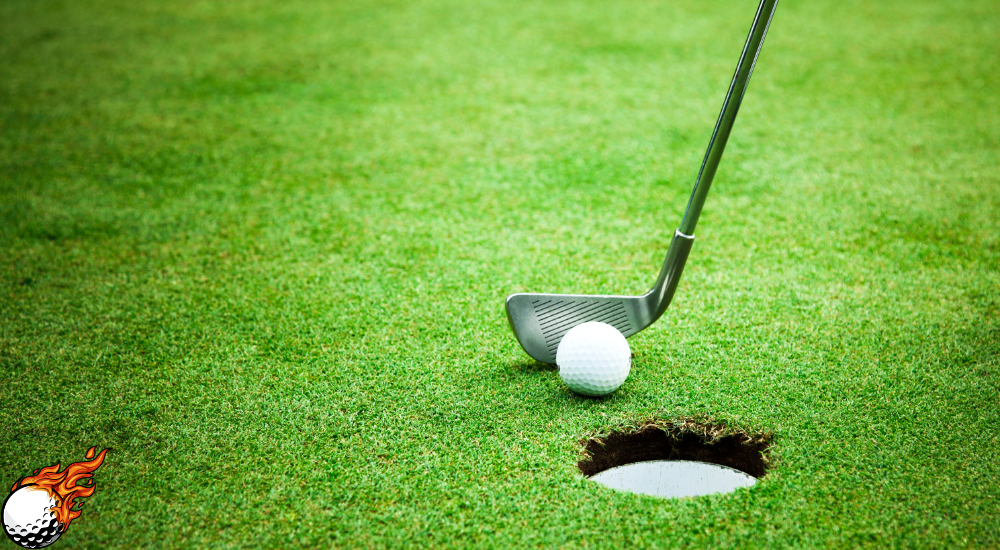
Have you ever watched a golf tournament in which the guy with the lowest score wins?
That’s stroke play (also known as medal play). Now, imagine a golf duel in which players face off head-to-head, battling it out on each hole. That’s a match Play.
Forget about the total number of strokes; in match play, it’s all about winning more holes than your opponent. Even if you mess up on one hole, you can bounce back and win the next.
Let’s dive into the exciting world of match-play golf!
- Match Play: A head-to-head golf format where players compete hole by hole.
- Scoring: The player who wins the most holes wins the match, regardless of their overall score.
- Strategy: Match play requires a different approach than stroke play, focusing on winning each hole rather than the overall score.
- Famous Events: Match play is used in prestigious tournaments like the Ryder Cup and the WGC-Dell Technologies Match Play.
- Casual Play: You can easily set up your match-play competition with friends for a fun and competitive round of golf.
What is Match Play in Golf?
- Head-to-Head: Match play is a style of golf where you play directly against one other player.
- Hole by Hole: Instead of keeping score for the whole round, you compete on each hole individually.
- Winning a Hole: The player with the lowest score on a single hole wins that hole.
- “Up” or “Down”: If you win a hole, you’re “1 up.” Lose a hole? You’re “1 down.” Tie a hole? It’s “all square.”
- Match Winner: The player who wins the most holes by the end of the match (usually 18 holes) is the winner.
- Forget the Stroke Count: Unlike regular golf (stroke play), your total number of shots doesn’t matter in match play. It’s all about winning more holes.
- Every Hole Counts: Each hole is a fresh start, so even if you have a bad hole, you can still come back and win the match!

This format makes match play super exciting. It’s like a mini-battle on every hole!
It’s All About the Holes
Unlike stroke play, where your total strokes are counted, match play scoring is all about how many holes you win compared to your opponent.
Here’s the lowdown:
- Up and Down: You’ll hear the terms “up” and “down” a lot in match play. If you’re winning, you’re “up” by a certain number of holes. If you’re losing, you’re “down” by a certain number.
- All Square: If you and your opponent have won the same number of holes, the match is “all square” or tied.
- Winning a Match: To win a match, you need to be “up” by more holes than there are holes left to play. For example, if you’re three holes up with only two holes left, you win!
- Dormie: This is a special term used when you’re “up” by the exact number of holes remaining. If you’re two up with two holes to play, you’re “dormie.” This means your opponent can’t win, but they can still tie the match.
At the end of the match, the player who has won more holes is declared the winner. If you both have won the same number of holes, the game is a tie.
In team matches, like the Ryder Cup, the team with the most points at the end wins. Each game within the team competition is worth a moment for the winning team.
If an individual game ends in a tie, both teams get half a point.
Match Play Strategy
Match play isn’t just about hitting the ball well—it’s also a mental game.
The strategies and tactics in match play are different from those in stroke play.
Here’s why:

- Hole by Hole Focus: In stroke play, you’re trying to get the lowest score over the entire golf course. In match play, you only need to beat your opponent on each hole. This changes how you approach each shot.
- Aggression vs. Caution: Sometimes, taking a risk might be the right move in match play, even if it wouldn’t be in stroke play. If you’re behind, you might need to go for a tough shot to try and win the hole. But if you’re ahead, you might play more conservatively to protect your lead.
- Playing the Opponent: Match play is as much about psychology as it is about golf skills. You need to read your opponent and adjust your strategy based on how they’re playing. If they’re struggling, you might be more aggressive. If they’re playing well, you might need to be more patient.
- Conceding Putts: In match play, it’s common for players to concede short putts (meaning they agree the other player made the putt without actually having to hit it). This speeds up play and can be a friendly gesture.
- The Dormie Effect: Being “dormie” changes everything. If you’re dormie, you only need to tie the remaining holes to win the match. This means you can play very cautiously, making sure not to make any big mistakes.
Example:
Let’s go back to your match against Player B. You’re one up on the 17th hole (a par 3).
- Stroke Play Mindset: You’d probably aim for the green and try to make par.
- Match Play Mindset: Since you only need to tie this hole to win the match, you might choose to hit a safe shot to the middle of the green, even if it means giving up a chance at a birdie.
This strategic approach to match play adds an extra layer of excitement to the game. Every decision matters and the momentum can shift in any hole!
Famous Match Play Events
Match play is more than just a fun format to try with your buddies on the weekend.
It’s also used in some of the most prestigious golf competitions around the world:
Professional Match Play Events:
- WGC-Dell Technologies Match Play: This is a big tournament in which the top golfers in the world compete in a match-play format. It’s thrilling to watch because of the head-to-head battles and unpredictable outcomes.
- The Ryder Cup and The Presidents Cup: These are team match play events where teams from the United States compete against teams from Europe (Ryder Cup) or the rest of the world (Presidents Cup). The excitement is off the charts, with players representing their countries and passionate fans cheering them on.

Amateur Match Play Events
Many amateur tournaments also use a match-play format.
Some popular examples include:
- USGA Amateur Championships: The USGA (United States Golf Association) holds various amateur championships that feature match play, including the U.S. Amateur and the U.S. Women’s Amateur.
- Club Championships: Many golf clubs have their club championships with a match-play format. It’s a great way for members to compete against each other and show off their skills.
Match Play with Your Friends
You don’t have to be a pro to enjoy matchplay!
It’s a great way to spice up your regular rounds with friends.
Just pick a format (like best ball match play, where the best score on each hole counts for the team), set some friendly wagers, and enjoy the competition.
Match Play Rules
While match play and stroke play share many of the same golf rules, there are some key differences to keep in mind:
Stroke Play Scoring System
- Hole by Hole: In match play, each hole is a separate competition. The golfer with the fewest number of strokes on a particular hole wins that hole.
- Winning a Hole: A win on a hole is worth one point. If both players have the same score on a hole (a tie), it’s called a halved hole, and neither player gets a point.
- Match Winner: The winner of the match is the player who has won more holes than their opponent when there aren’t enough holes left to even the game.
- Team Events: In team match play, like the Ryder Cup, teams earn points for winning holes. Sometimes, formats like “four-ball” are played, where two players from each team play each hole, and the team with the lowest score on that hole wins it.
Other Match Play Rules
- Concessions: A player can concede a hole (give it to their opponent) or even concede the entire match at any time.
- Order of Play: In stroke play, the player with the lowest score on the previous hole usually tees off first. In match play, the order of play on the first hole is often determined by a coin toss. On subsequent holes, the player who won the previous hole tees off first.
- Gimme Putts: It’s common in match play for players to give each other short putts, called “gimmes,” without actually having to put them. This speeds up play and is considered good sportsmanship.
- Local Rules: Always check for any local rules before playing a match, as they might differ slightly from standard golf rules.
Example:
Let’s say you’re playing a match play round against a friend.
On the first hole, you both score a 5. This is a tie, so no one wins the hole. On the second hole, you score a four, and your friend scores a 6.
You win the second hole and are now “1 up.” If you continue to win more holes than your friend, you’ll win the match!
Conclusion

So there you have it! Match play golf is a whole different animal compared to the usual stroke play you see on TV.
It’s a head-to-head battle in which you need only to beat your opponent on each hole, not have the lowest overall score.
This makes match play super exciting and unpredictable, with every hole feeling like a mini-tournament.
Whether you’re watching a big match play event like the Ryder Cup or just trying it out with your friends, it’s a guaranteed good time. So next time you’re on the golf course, why not give match play a shot?
You might discover a whole new way to enjoy the game!
Frequently Asked Questions
What if a match play competition is tied after the final hole?
If the match is all square after the regular number of the same hole (usually 18), it goes into a sudden-death playoff. The players continue playing until one player wins a hole, which determines the winner of the match. This differs from stroke play tournaments, where total score over all holes is the deciding factor.
Can I play match play with just two players?
Absolutely! In fact, most match plays are between two individual players. You can easily set up your match-play competition with a friend at your local golf course. It’s a fun way to practice head-to-head competition and test your skills against someone else.
How are handicaps used in match play?
Handicaps can be used in match play or even in matches between players of different skill levels. The higher handicap player receives a certain number of strokes based on the difference in their handicaps. These strokes are usually applied to the most difficult holes won on the course, giving the higher handicapper a better chance to win those holes.
What happens if a player can’t finish a hole-in-match play?
If a player cannot finish a hole for any reason (lost ball, injury, etc.), they lose that hole. Even The match continues to the next hole, and the player’s score for the unfinished hole does not affect their final score.
Are there any team match-play events?
Yes! Some of the most famous golf tournaments in the world are team match-play events, like the Ryder Cup and the Presidents Cup. In these events, teams of golfers from different countries compete against each other in an individual match-play format. Each match contributes points to the overall team score, and the team with the most points at the end of the tournament wins.













